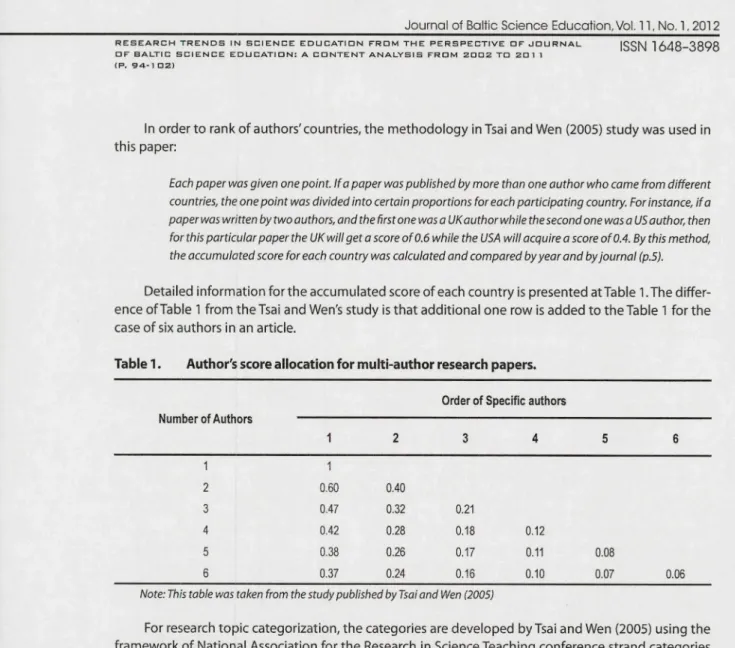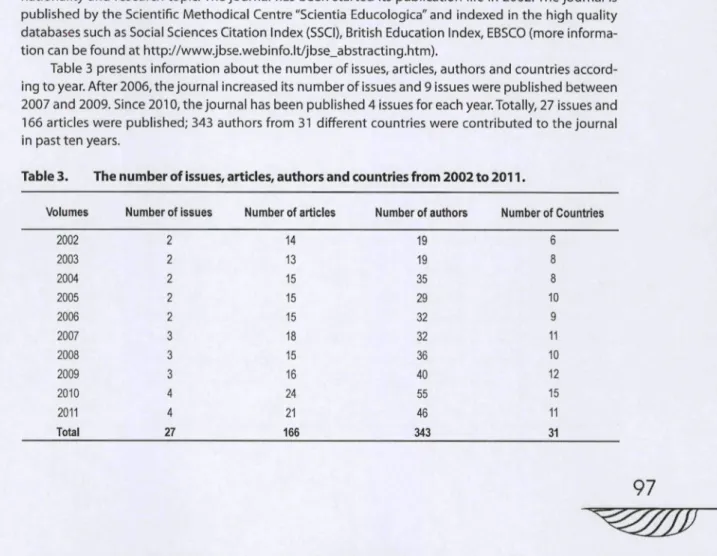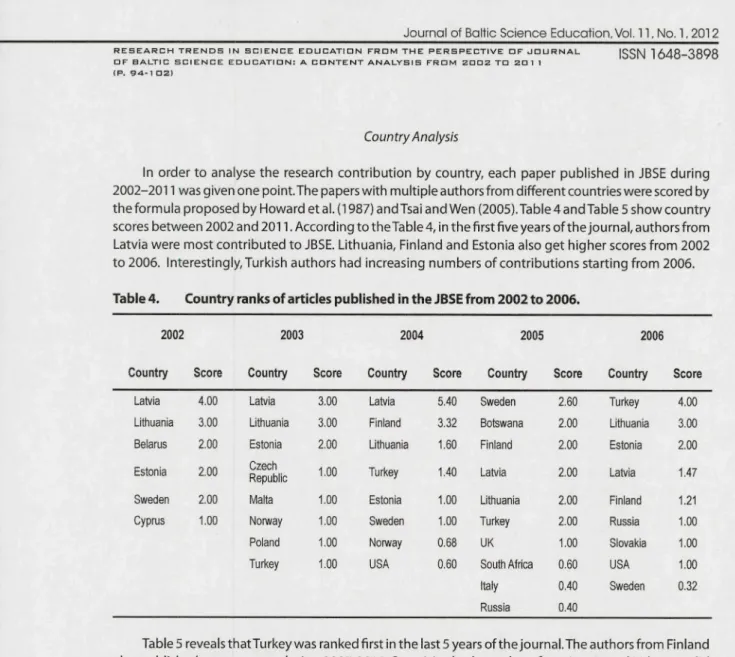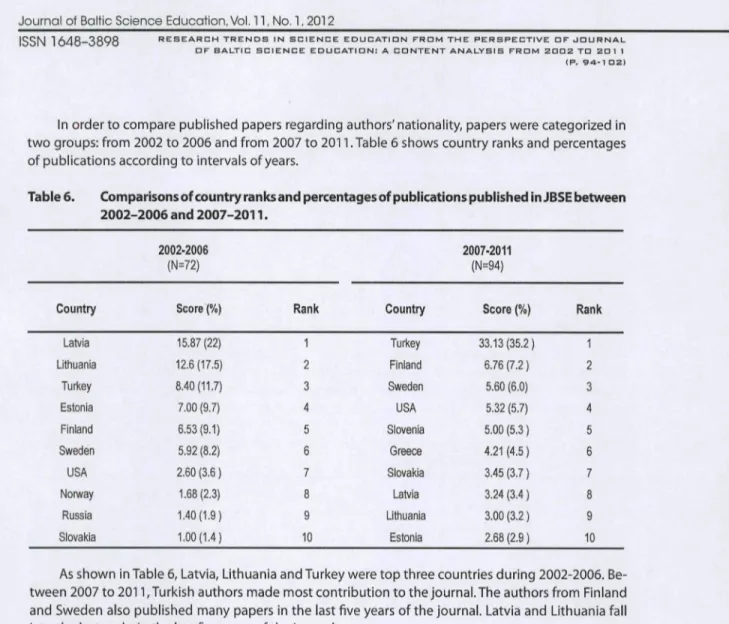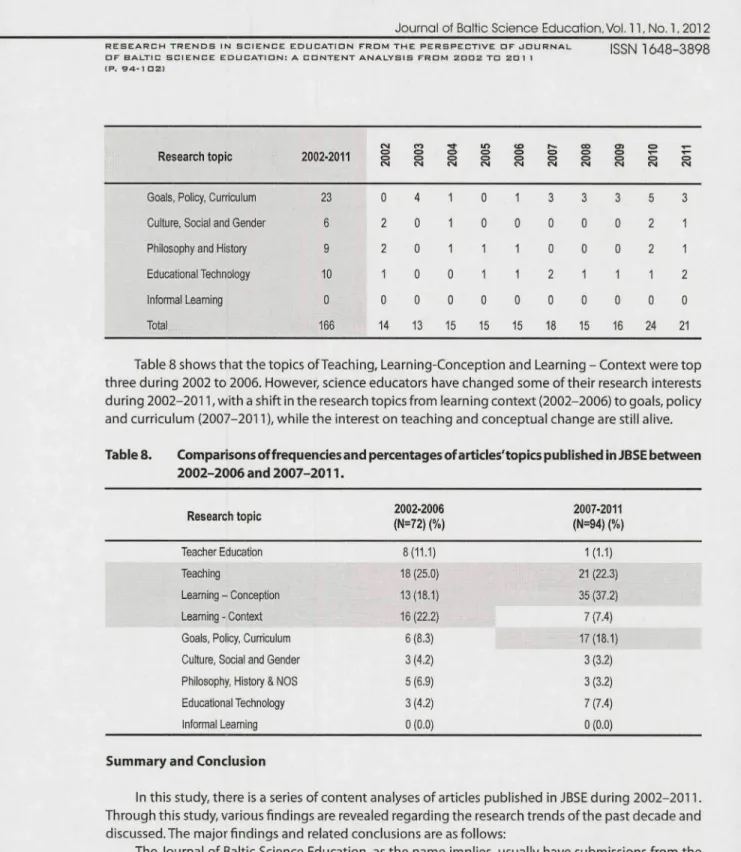ISSN 1648-3898
Abstract. The main aim ofthis research is to analyse ten volumes of Journai of Baltic
Science Education (JBSE) according to the authors' nationaiity and research topics
ofthe articles published in the journai between 2002 and 2011. The journal published ten voiumes, 27 issue and 166 articies since 2002. The artides were sub-mitted by 343 authors from 31 countries. Statistical analyses show that the authors from Turkey are ranking highest in terms ofthe number of pubiished papers. Latvia and Lithuania follow Turkey as second and
third countries. The study found out that the articles regarding learning-conception,
teaching, learning-context and goais, poiicy and curricuium most frequently investigated by the researchers. However, in 2002-2011, there is no articie related to
informal learning. The researchers gave less attention to cultural, social and gen-der issues when compared other research
topics in the scope of JBSE. Key words: content analysis. Journal of
Baltic Science Education.
Bulent Cavas Dokuz Eyiui University, Turkey
Pinar Cavas Ege University, Turkey
Yasemin Ozdem Gaziosmanpasa University, Turkey
Miia Rannikmae University of Tartu, Estonia
Hamide Ertepinar Istanbul Aydin University, Turkey
R E S E A R C H T R E N D S I N
S C I E N C E
E D U C A T I O N
F R D M T H E
P E R S P E C T I V E
O F
J O U R N A L O F B A L T I C
S C I E N C E E D U C A T I O N : A
C O N T E N T
A N A L Y S I S F R O M
2 D D 2
TO 2 D 1
1
Bulent
Cavas,
Pinar Cavas,
Yasemin Ozdem,
Miia Rannikmae,
Hamide Ertepinar
IntroductionIt is important for all science educators and researchers to publish their studies as an article in a journal which indexed in Social Sciences Citation Index (SSCI). It is by means ofthe indexed publications that the research and the researcher can be widely recognized in the academic community and get reputation in science education arena. As much important through indexed publications, the researchers can advance in their careers (Henson, 2001; Tsai & Wen, 2005). Similarly, science education community often view the publications in indexed journals as an important task since the articles in these journals usually have high quality both in terms of strong research methodology and high level discussions. However, publishing an article in SSCI based science education journal isa kind ofchallengefor researchers who have newly started to their career in science education. It is not easy for them to design research questions, put hypotheses, writing results and maybe the most important preparing discussion integrated with the findings and the other studies on the same field. Therefore, especially for new researchers, it is important to be aware of not only the current status and future trends of research but also how the science education research are shaped by the theories from a wide variety offields.This awareness will help them to understand the field of science education from a broader perspective. Meta-analysis or systematic reviews of research published in academic
Journal of Baltic Science Education, Vol. 11, No. 1, 2012
ISSN 1648—3898 RESEARCH TRENDS IN SCIENCE EDUCATION FROM THE PERSPECTIVE DF JOURNAL OF BALTIC SCIENCE EDUCATION: A CONTENT ANALYSIS FROM 2 0 0 2 TO 2D 1 1
IP. 94-1 D2)
Journals, in this sense, is helpful for researchers in identifying key trends in the way that knowledge gets constructed in a discipline.They are also crucial in identifying where gaps in understanding might exist and where future emphases in research might need to be placed (Ozdem, Erduran, & Park, 2011).
There has been a number of valuable systematic investigation ofthe research trends published in academic journals in science education area in general (Rennie, 1998; Eybe & Schmidt, 2001 ;Tsai & Wen, 2005; Lee, Wu, &Tsai, 2009) and in specific studies, such as scientific literacy (e.g. Deboer, 2000; Laugksch, 2000), concept development (e.g. Chiappetta, 1976; Driver & Easley, 1978), conceptions of nature of science (e.g. Lederman, 1992; Abd-EI-Khalick & Lederman, 2000), laboratory in science education (e.g. Hofstein & Lunetta, 2004; 1982), attitudes towards science (e.g. Gardner, 1975; Gauld & Hukkins, 1980; Osborne, Simon, & Collins, 2003) and argumentation (e.g. DuschI & Osborne, 2002; Ozdem, Erduran, & Park, 2011). Although these investigations provide an overview ofthe perspectives in science education research, there is always need for up-to-date reports for the research community of the time.
One ofthe major reviews recently published in the field of science education was conducted by Lee et al (2009).The authors explored the research trends in science education beginning from 2003 to 2007 through content analysis of a total of 869 papers published in the three most important journals of science education: the International Journal of Science Education (USE), Science Education (SE), and theJournalof Research in Science Teaching (JRST).This study was a follow-up on similar work conducted by the same researchers in a previous paper (Tsai & Wen, 2005).Through systematic reviews of literature covering 10 years, they illustrated some broad trends about research in science education and outlined some detailed observations on particular issues as well. For example, they reported that during the last five years, science education researchers showed increasing interest in research topics involving the context of student learning. Furthermore, research interests changed with a shift from student concep-tion learning and conceptual change (1998-2002) to student learning contexts (2003-2007).
This research may also help science education researchers to understand the publication policy and trend of the Journal of Baltic Science Education as an indexed academic journal in past ten years as well to serve a resource which is a guide to the research trends in science education through an indexed journal. Journal of Baltic Science Education is one ofthe leading journals in science education and publish approximately 15 articles per year in 4 issues. The centre of journal is Lithuania and jour-nal consists of internatiojour-nal editorial board members. The Jourjour-nal of Baltic Science Education (JBSE) started its publication in 2002 (received acceptance from SSCI in 2008) and now ten years completed. This article, therefore, investigates the content analyses of the journal in terms of authors' nationality, research topics and includes some statistical analyses ofthe articles published from 2002 to 2011. In sum, the current study addresses the following research questions:
1. How did authors from different countries contribute to the publications of JBSE from 2002 to 2011?
2. How did the topics of the published papers in JBSE vary across these ten years (2002-2011)?
3. How did the research trends, including country contribution, and research topic ofthe articles published in JBSE vary from 2002 to 2011 ?
Methodology of Research
The study presented here consists of articles published in the Journal of Baltic Science Education from 2002 to 2011 (10 years). A total of 166 articles examined according to nationality of author/s and the topic ofthe article. However, some informative documents such as editorial sections, celebrities and book reviews have been excluded from the study.
The analysis method used by Tsai and Wen (2005) and Lee, Wu andTsai (2009) was selected. There are three reasons for selection of analysis method of Tsai and Wen: first, it provides a simple, easy and understandable method; second, it also provides an opportunity for researchers to compare the journals indicated in Tsai and Wen's study with the current study; and third, this method of review is the most recent one used among the science education research reviews. For this reason, the same methodology for country ranks and research topics was implemented in this study.
Journal of Baltio Science Education, Vol. 11, No. 1. 2012
RESEARCH TRENDS IN SCIENCE EDUCATION FROM THE PERSPECTIVE OF JOURNAL OF BALTIC SCIENCE EDU CATION: A CONTENT ANALYSIS FROM 2aD2 TO 2D 1 1 (P. 94.-1 021
ISSN 1648-3898
In orderto rankof authors'countries, the methodology in Tsai and Wen (2005) study was used in this paper:
Each paper was given one point. If a paper was published by more than one author who came from different countries, the one point was divided into certain proportions for each participating country. For instance, if a paper was written by two authors, and the first one was a UK author while the second one was a US author, then for this particular paper the UK will get a score of 0.6 while the USA will acquire a score of 0.4. By this method, the accumulated score for each country was calculated and compared by year and by journal (p.5).
Detailed information for the accumulated score of each country is presented at Table 1 .The differ-ence of Table 1 from the Tsai and Wen's study is that additional one row is added to the Table 1 for the case of six authors in an article.
Table 1. Author's score allocation for multi-author research papers.
Number of Authors 1 2 3 4 5 6 1 1 0.60 0.47 0,42 0.38 0.37 2 040 0,32 0.28 0.26 0.24
Order of Specific authors
3 0.21 0.18 0.17 0.16 4 0.12 0.11 0.10 5 0.08 0.07 6 0.06
Note: This table was taken from the study published by Tsai and Wen (2005)
For research topic categorization, the categories are developed by Tsai and Wen (2005) using the framework of National Association for the Research in Science Teaching conference strand categories (http://www.educ.sfu.ca/narst/sub-g-proc.htmltt47858) and the same categorization is used in this paper as well. More detailed information can be found on the categorization of research topics at Table 2.
Table 2. Category table for research topics.
No. The name of category Category explanation 1 Teacher Education
2 Teaching
3 Leaming - Students' Conceptions and Conceptual Change (Learning -Conception)
4 Learning - Classroom Contexts and Learner Characteristics (Leaning -Context)
Pre-service and continuing professional development of teachers; teacher education programs and policy; field experience; issues related to teacher education reform; teacher as researcher/action research.
Teacher cognition; pedagogical knowledge and pedagogical content knowledge; forms of knowledge representation (e.g. metaphors, images, etc.); leadership; induction; exemplary teachers; teacher thinking; teaching behaviours and strategies. Methods for investigating student understanding; students' alternative conceptions; instmctional approaches for conceptual change; conceptual change in learners; conceptual development.
Student motivation; learning environment; individual differences; reasoning; learning approaches; exceptionality; teacher-student interactions; peer interactions; labora-tory environments; affective dimensions of science learning; cooperative learning; language, writing and discourse in learning; social, political, and economic factors.
Journal of Baltic Science Education, Vol. 11, No. 1. 2012
ISSN 1648-3898 RESEARCH TRENDS IN SCIENCE EDUCATION FRDM THE PERSPECTIVE DF JDURNAL DF BALTIC SCIENCE EDUCATIDN: A CDNTENT ANALYSIS FRDM 2aD2 TD 2D 1 1 (P. 94-1 D3)
No. The name of category Category explanation 5 Goals and Policy, Curriculum,
Evalua-tion, and Assessment
6 Cultural, Social and Gender issues.
7 History, Philosophy, Epistemology and Nature of Science. 8 Educational Technology
9 Informal Leanning
Curriculum development, change, implementation, dissemination and evaluation; social analysis of curriculum; altemative forms of assessment; teacher evaluation; educational measurement; identifying effective schools; curriculum policy and reform. Multicultural and bilingual issues; ethnic issues; gender issues; comparative studies; issues of diversity related to science teaching and learning.
Historical Issues; philosophical issues; epistemological issues; ethical and moral is-sues; nature of science; research methods.
Computers; interactive multimedia; video; integration of technology into teaching; learning and assessment involving the use of technology.
Science learning in informal contexts (e.g. museums, outdoor settings, etc.); public awareness of science.
Results of Research
In this study, all ofthe published papers, excluding editorial sections, celebrities and book reviews, in JBSE were analysed by authors' nationality and research topic.The results of this study were presented in three parts: general analysis on the journal, which consist ofthe issues, articles, authors and countries from 2002 to 2011 ; analyses of published papers during the years 2002-2011 in terms of authors' nation-ality, and analyses of published papers during the years 2002-2011 in terms of research topics.
General Analysis on the Journal
In this section, all papers published in JBSE from 2002 to 2011 were analysed regarding authors' nationality and research topic. The journal has been started its publication life in 2002. The journal is published by the Scientific Methodical Centre "Scientia Educologica"and indexed in the high quality databases such as Social Sciences Citation Index (SSCI), British Education Index, EBSCO (more informa-tion can be found at http://www.jbse.webinfo.lt/jbse_abstracting.htm).
Table 3 presents information about the number of issues, articles, authors and countries accord-ing to year. After 2006, the journal increased its number of issues and 9 issues were published between 2007 and 2009. Since 2010, the journal has been published 4 issues for each year. Totally, 27 issues and 166 articles were published; 343 authors from 31 different countries were contributed to the journal in past ten years.
Table 3. The number of issues, articles, authors and countries from 2002 to 2011.
Volumes 2002 2003 2004 2005 2006 2007 2008 2009 2010 2011 Total Number of issues 2 2 2 C N 2 3 3 3 4 4 27 Number of articles 14 13 15 15 15 18 15 16 24 21 166 Number of authors 19 19 35 29 32 32 36 40 55 46 343 Number of Countries 6 8 8 10 9 11 10 12 15 11 31
Journal of Baltic Science Education. Vol. 11. No. 1. 2012 RESEARCH TRENDS IN SCIENCE EDUCATION FROM THE PERSPECTIVE OF JOURNAL
o r BALTIC SCIENCE EDUCATION: A CONTENT ANALYSIS FROM ZaQ2 TO SD 1 1 (P. 94-1 D2)
ISSN 1648-3898
Country Analysis
In order to analyse the research contribution by country, each paper published in JBSE during 2002-2011 was given one point.The papers with multiple authors from different countries were scored by the formula proposed by Howard et al. (1987) and Tsai and Wen (2005). Table 4 and Table 5 show country scores between 2002 and 2011. According to theTable 4, in the first five years of the journal, authors from Latvia were most contributed to JBSE. Lithuania, Finland and Estonia also get higher scores from 2002 to 2006. Interestingly, Turkish authors had increasing numbers of contributions starting from 2006.
Table 4. Country ranks of articles published In the JBSE from 2002 to 2006.
2002 2003 2004 2005 2006
Country Score Country Score Country Score Country Score Country Score
Latvia Lithuania Belarus Estonia Sweden Cyprus 4.00 3.00 2.00 2.00 2.00 1.00 Latvia Lithuania Estonia Czech Republic Malta Nonfl/ay Poland Turkey 3.00 3.00 2.00 1.00 1.00 1.00 1.00 1.00 Latvia Finland Lithuania Turkey Estonia Sweden NonA/ay USA 5.40 3.32 1.60 1.40 1.00 1.00 0.68 0.60 Sweden Botswana Finland Latvia Lithuania Turkey UK South Africa Italy Russia 2.60 2.00 2.00 2.00 2.00 2.00 1.00 0.60 0.40 0.40 Turkey Lithuania Estonia Latvia Finland Russia Slovakia USA Sweden 4.00 3.00 2.00 1.47 1.21 1.00 1.00 1.00 0.32
Table 5 reveals that Turkey was ranked first in the last 5 years of the journal.The authors from Finland also published many papers during 2007-2011. Surprisingly, the authors from Latvia and Lithuania did not make contributions to the journal as they did in the first years of the journal.
Table 5. Country ranks of publications published in JBSE between 2007 to 2011.
2007 2008 2009 2010 2011
Country Score Country Score Country Score Country Score Country Score
Turkey Sweden Bulgaria Finland Hungary Lithuania Netherlands Slovakia Slovenia USA 7.00 2.60 1.00 1.00 100 1.00 1.00 1.00 1.00 1.00 Turkey Finland Latvia Slovakia Botswana Germany Greece Poland Estonia USA 5.82 1.76 1.24 1.18 1.00 1.00 1.00 1.00 0.68 0.32 Turkey USA Botswana Czech Republic Estonia Latvia Lithuania Norway UK Slovakia 5.20 2.00 1.00 1.00 1.00 1.00 1.00 1.00 1.00 0.80 Turkey Finland Malta Sweden USA UK Greece Germany Latvia Slovenia-Spain 6.58 2.00 2.00 2.00 2.00 1.79 1.61 1.21 1.00 1.00 Turkey Slovenia Finland Greece Estonia Lithuania Portugal Sweden USA Slovakia 8.53 3.00 2.00 1.60 1.00 1.00 1.00 1.00 1.00 0.47
Journal of Baltic Science Education. Vol. 11, No. 1, 2012
ISSN 1 Ó48—3898 RESEARCH TRENDS I N SCIENCE EDUCATION FROM THE PERSPECTIVE DF JOURNAL OF BALTIC SCIENCE EDUCATION: A CONTENT ANALYSIS FROM ZDD2 TO 2O 1 ) (P. 94-1 OZ)
In orderto compare published papers regarding authors'nationality, papers were categorized in two groups: from 2002 to 2006 and from 2007 to 2011 .Table 6 shows country ranks and percentages of publications according to intervals of years.
Tablea. Comparisonsofcountryranksandpercentagesofpublicationspublished in JBSE between 2002-2006 and 2007-2011. Country Latvia Lithuania Tur1<ey Estonia Finland Sweden USA Norway Russia Slovakia 2002-2006 (N=72) Score (%) 15.87(22) 12.6(17.5) 8.40(11.7) 7.00 (9.7) 6.53(9.1) 5.92 (8.2) 2.60 (3.6 ) 1.68(2.3) 1.40(1.9) 1.00(1.4) Rank 1 2 3 4 5 6 7 8 9 10 Country Turkey Finland Sweden USA Slovenia Greece Slovakia Latvia Lithuania Estonia 2007-2011 (N=94) Score (%) 33.13(35.2) 6.76 (7.2 ) 5.60 (6.0) 5.32 (5.7) 5.00 (5.3 ) 4.21 (4.5 ) 3.45 (3.7 ) 3.24 (3.4 ) 3.00 (3.2 ) 2.68 (2.9 ) Rank 1 C M 3 4 5 6 7 8 9 10
As shown in Table 6, Latvia, Lithuania and Turkey were top three countries during 2002-2006. Be-tween 2007 to 2011, Turkish authors made most contribution to the journal. The authors from Finland and Sweden also published many papers in the last five years of the journal. Latvia and Lithuania fall into the last ranks in the last five years ofthe journal.
When the analysed the total scores from 2002 to 2011, it if found that Turkey is at the first rank with the score of 41.53; Latvia is the second with the score of 19.11 and the Lithuania is the third country with the score of 15.60.
Research Topics
Table 7 presents frequencies of articles'topics published in the journal between 2002 and 2011. As shown in Table 7, within these ten years in the JBSE the most published papers are those regarding Learning-Conceptions,Teaching (39), Learning-Context (23) and Goals, Policy and Gender (23). It should also be noted that researchers in science education also displayed considerable interest in research regarding Culture, Social and Gender (6), Philosophy and History (9),Teacher Education (9), Educational Technology (10). Furthermore, there is no article on the informal learning in the journal's life period.
Table 7. Frequencies of articles'topics in the JBSE from 2002 to 2011.
Research topic Teacher Education Teaching Leaming - Conception Leaming - Context 2002-2011 9 39 48 23 300 3 3 2 3 1
200
3
2 4 2 1200
4
3 2 2 5200
5
0 7 3 3 900 3 0 3 3 6200
7
0 5 7 11
0 0 9 2 600 3 0 7 3 2201
0
0 3 11 0201
1
1 6 5 2Journal of Baltic Science Education, Vol. 11, No. 1,2012 RESEARCH TRENDS IN SCIENCE EDUCATION FRDM THE PERSPECTIVE OF JOURNAL ISSN 1 6 4 8 - 3 8 9 8 OF BALTIC SCIENCE EDUCATION: A CONTENT ANALYSIS FROM ZaD2 TO 2D1 1
(P. 9.4-1 GZ)
Research topic
Goals, Policy, Curriculum Culture, Social and Gender Philosophy and History Educational Technology Informal Learning Total 2002-2011 23 6 9 10 0 166
200
2
0 2 CN I 1 0 14200
3
4 0 0 0 0 13200
4
1 1 1 0 0 15200
5
0 0 1 1 0 15200
6
1 0 1 1 0 15200
7
3 0 0 2 0 18200
8
3 0 0 1 0 15200
9
3 0 0 1 0 16201
0
5 2 2 1 0 24201
1
3 1 1 2 0 21Table 8 shows that the topics of Teaching, Learning-Conception and Learning - Context were top three during 2002 to 2006. However, science educators have changed some of their research interests during 2002-2011, with a shift in the research topics from learning context (2002-2006) to goals, policy and curriculum (2007-2011 ), while the interest on teaching and conceptual change are still alive.
Table 8. Comparisons of frequencies and percentages of articies'topics published in JBSE between 2002-2006 and 2007-2011. D.e„o .h * „ V 2002-2006 2007-2011 Research topic ^^^^2)(%) (N=94)(%) Teacher Education Teaching Learning - Conception Learning - Context Goals, Policy, Curriculum Culture, Social and Gender Philosophy, History & NOS Educational Technology Informai Learning 8(11.1) 18 (25.0) 13(18.1) 16 (22.2) 6 (8.3) 3(4.2) 5(6.9) 3(4.2) 0 (0.0) 21 (22.3) 35 (37.2) 7 (7.4) 17(18.1) 3 (3.2) 3 (3.2) 7 (7.4) 0 (0.0) Summary and Conclusion
In this study, there isa seriesof content analyses of articles published in JBSE during 2002-2011. Through this study, various findings are revealed regarding the research trends ofthe past decade and discussed. The major findings and related conclusions are as follows:
The Journal of Baltic Science Education, as the name implies, usually have submissions from the Baltic countries. Especially in the earlier issues ofthe JBSE, that is between the years 2002-2006, the published papers were submitted by the authors from Estonia, Latvia, Lithuania (from north to south) and Finland. Belarus, Botswana and Sweden were on the lists for a year only.The only exceptional country wasTurkey. Interestingly, since 2006, published papers list has been populated by Turkey considerably. This interest of Turkish science education researchers can be attributed to the indexing of JBSE in the lists of well-known educational indexes such as EBSCO Information Services and International Index Copernicus Journal Master List beginning from the year 2004-2005.
In the last five years of journal (2007-2011 ), Turkey has been continually contributed significantly to the journal. When the number of science education researchers In Turkey is compared to the Baltic countries, the difference in the scores given in Table 4 and 5 becomes meaningful. Although we do not have exact numbers, the number of science education researchers in Turkey is expectedly more than
Journal of Baltic Science Education. Vol. 11, No. 1. 2012
ISSN 1648-3898 RESEARCH TRENDS IN SCIENCE EDUCATION FROM THE PERSPECTIVE OF JOURNAL OF BALTIC SCIENCE EDUCATION: A CONTENT ANALYSIS FROM ZOn2 TO 20 1 1 (P. 94-1 G2)
Baltic countries since Turkey has a population more than 72 million, which makes her highly populated compared to most ofthe Baltic countries, whose populations are about 2 million (e.g. Estonia 1,340,194; Latvia 2,067,900; and Lithuania 3,199,342 according to 2011 records). Another important reason forthe high number publication from Turkey is related to investment on the improving teacher education reform. Faculty and research fellows from education faculties were sent abroad to attend master, PhD, or Post Doctoral studies with a US$177.2 million loan (US$90.2 million from the World Bank and US$87 million from the Turkish Government). The World Bank loan has been taken provided that Higher Education Council revises and improves pre-service teacher training curricula, textbooks and pedagogical material and to support research projects (Guven, 2008). This support encourages more and more researchers from Turkey to enrol in graduate level programs in European and United States Universities. These researchers turn back to Turkey with high levels of writing, researching and understanding of English and reflect these abilities to their international research and publications.
When the scores of countries, excluding Turkey, is considered, Lithuania and Latvia were high ranking in terms ofthe publishing between the years 2002 and 2006. The indexing of the journal in well-known indexes shows its effect here as well because the contribution from other countries has been increasing since 2006. For example, Sweden, Bulgaria and USA have been submitted more papers compared to the earlier years of the journal. The overall contributions from the countries illustrate the importance of indexing inthe lifetime of the journal.
Inthe last ten years, the topics of the learning-conception, teaching, learning-context and goals, policy and curriculum were the most popular research topics among the science education research-ers who published articles in Journal of Baltic Science Education. The less attention was given to the research topics such as cultural, social and gender issues when compared other research topics. There was no research on the informal learning.The results show that research topics published in the journal slightly changed starting from 2007. The journal started to indexed in the important databases during 2007-2008 that this situation has moved journal more worldwide trends.
Acknowledgement
This research work is supported partly by the Estonian Science Foundation, grant number ESF Mobilitas MJD32.The author thanks to Estonian Science Foundation.
References
Abd-EI-Khalick, F., & Lederman, N.G. (2000). Improving science teachers' conceptions of the nature of science: A critical review of the literature. International Journal of Science Education, 22,665-701.
Chiappetta, E.L. (1976). A review of Piagetian studies relevant to science instruction at the secondary and college level. Science Education, 60 (2), 253-261.
Deboer, G. (2000). Scientific Literacy: Another look at Its Historical and Contemporary Meanings and Its Relationship to Science Education Reform. Journai of Research In Science Teaching, 37 (6), 582-601.
Driver, R., & Easley, J. (1978). Pupils and paradigms: A review of literature related to concept development in adoles-cent science students. Studies in Science Education, 5,61 -84.
DuschI, R., & Osborne, J. (2002). Supporting and promoting argumentation discourse. Studies in Science Education,
38, 39-72.
Eybe, J., & Schmidt, H.-J. (2001 ). Quality criteria and exemplary papers in chemistry education research. International
Journal of Science Education, 23, 209-225.
Henson, K.T (2001 ). Writing for professional journals: Paradoxes and promises. Phi Delta Kappan, 82,765-768. Gardner, P. L (1975). Attitudes to science: A review. Studies in Science Education, 2 (1 ), 1 -41.
Gauld, C. F., & Hukins, A. A. (1980). Scientific Attitudes: a Review. Studies in Science Education, 7,129-161. Guven, I. (2008) Teacher Education Reform and International Globalization Hegemony: Issues and Challenges in
Turkish Teacher Education./nfemat/ono/ioumo/of Hivmtjnond Soda/Sc/ences, 3 (1), 8-17.
Hofstein, A., & Lunetta, V. (1982).The role ofthe laboratory in science teaching: Neglected aspects of research. Review
of Education Research, 52, 201 -218.
Hofstein, A., & Lunetta, V. (2004). The laboratory in science education: Foundations for the Twenty-First Century.
Science Education, SS (1 ), 28-54.
Journal of Baltic Science Education, Vol. 11, No. 1,2012 RESEARCH TRENDS IN SCIENCE EDUCATÍDN FROM THE PERSPECTIVE DF JOURNAL
DF BALTIC SCIENCE EDUCATIDN: A CDNTENT ANALYSIS FRGM 2DD2 TO 2D1 1 (P. 94-1 O2I
ISSN 1648-3898
Lederman, N. G. (1992). Students'and teachers'conceptions ofthe nature of science: A review ofthe research. Journo/ of Research in Science Teaching, 29,331 -359.
Lee, M. H., Wu, Y. T., &Tsai, C. C (2009). Research trends in science education from 2003 to 2007: A content analysis of publications in selected journals. International Journal of Science Education, 31 (15), 1999-2020.
Osborne, J. F., Simon, S. & Collins, S. (2003). Attitudes towards Science: A review ofthe literature and its implications. internationai Journai of Science Education, 25,1049-1079.
Ozdem, Y., Erduran, S., & Park, J. Y. (2011, September 5-9). The deveiopment of an argumentation theory in science education. Paper presented at the meeting of European Science Education Research Association (ESERA), Lyon, France.
Rennie, L.J. (1998). Guest editorial: Improving the interpretation and reporting of quantitative research, ./oumo/of Research in Science Teaching, 35, 237-248.
Tsai, C, Wen, M. (2005). Research and trends in science education from 1998 to 2002: a content analysis of publica-tion in selected journals, internapublica-tionai Journal of Science Educapublica-tion, 27 (1 ), 3-14.
Received: February 29,2012 Accepted: March 16,2012
Bulent Cavas
Pinar Cavas
Yasemin Ozdem
Miia Rannikmae
Hamide Ertepinar
Associate Professor, Dokuz Eyiul University, Department of Science Education, Turkey.
Member ofthe Editorial Board of JBSE E-mail: bulent.cavas@deu.edu.tr
Website: http://people.deu.edu.tr/bulent.cavas
Assistant Professor, Ege University, Department of Elementary Education, Turkey.
E-mail: pinar.huyuguzel@ege.edu.tr
Research Assistant, Gaziosmanpasa University, Department of Elementary Education,Turkey.
E-mail: yozdem@metu.edu.tr
Professor, University of Tartu, Centre of Science Education, Estonia. E-mail: miia@ut.ee
Professor, Istanbul Aydin University, Department of Elementary Education, Turkey.
